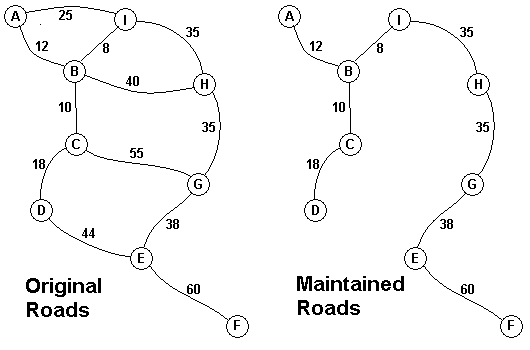标签:
Time Limit: 2000/1000 MS (Java/Others) Memory Limit: 65536/32768 K (Java/Others)
Total Submission(s): 5037 Accepted Submission(s): 3656


1 #include <iostream> 2 #include <cstdio> 3 #include <string> 4 #include <queue> 5 #include <vector> 6 #include <map> 7 #include <algorithm> 8 #include <cstring> 9 #include <cctype> 10 #include <cstdlib> 11 #include <cmath> 12 #include <ctime> 13 using namespace std; 14 15 const int SIZE = 30; 16 bool VIS[SIZE]; 17 int N; 18 struct Node 19 { 20 int vec,cost; 21 bool operator <(const Node & r) const 22 { 23 return cost > r.cost; 24 } 25 }; 26 vector<Node> G[SIZE]; 27 28 int prime(void); 29 int main(void) 30 { 31 char ch; 32 int from,to,cost,k; 33 Node temp; 34 35 while(scanf("%d",&N) != EOF && N) 36 { 37 for(int i = 0;i < N;i ++) 38 G[i].clear(); 39 for(int i = 0;i < N - 1;i ++) 40 { 41 scanf(" %c%d",&ch,&k); 42 from = ch - ‘A‘; 43 while(k --) 44 { 45 scanf(" %c%d",&ch,&cost); 46 to = ch - ‘A‘; 47 temp.vec = to; 48 temp.cost = cost; 49 G[from].push_back(temp); 50 temp.vec = from; 51 G[to].push_back(temp); 52 } 53 } 54 printf("%d\n",prime()); 55 } 56 57 return 0; 58 } 59 60 int prime(void) 61 { 62 int ans = 0; 63 int num = 0; 64 Node temp; 65 priority_queue<Node> que; 66 temp.vec = temp.cost = 0; 67 que.push(temp); 68 fill(VIS,VIS + N,false); 69 70 while(!que.empty()) 71 { 72 Node cur = que.top(); 73 que.pop(); 74 if(VIS[cur.vec]) 75 continue; 76 ans += cur.cost; 77 num ++; 78 VIS[cur.vec] = true; 79 if(num == N) 80 break; 81 82 for(int i = 0;i < G[cur.vec].size();i ++) 83 if(!VIS[G[cur.vec][i].vec]) 84 que.push(G[cur.vec][i]); 85 } 86 87 return ans; 88 }

#include <iostream> #include <cstdio> #include <string> #include <queue> #include <vector> #include <map> #include <algorithm> #include <cstring> #include <cctype> #include <cstdlib> #include <cmath> #include <ctime> using namespace std; const int SIZE = 30; int FATHER[SIZE],N,NUM; struct Node { int from,to,cost; }G[100]; void ini(void); int find_father(int); void unite(int,int); bool same(int,int); int kruskal(void); bool comp(const Node &,const Node &); int main(void) { char ch; int from,to,cost,k; while(scanf("%d",&N) && N) { ini(); for(int i = 0;i < N - 1;i ++) { scanf(" %c%d",&ch,&k); from = ch - ‘A‘; while(k --) { scanf(" %c%d",&ch,&cost); to = ch - ‘A‘; G[NUM].from = from; G[NUM].to = to; G[NUM].cost = cost; NUM ++; } } printf("%d\n",kruskal()); } return 0; } void ini(void) { NUM = 0; for(int i = 0;i <= N;i ++) FATHER[i] = i; } int find_father(int n) { if(n == FATHER[n]) return n; return FATHER[n] = find_father(FATHER[n]); } void unite(int x,int y) { x = find_father(x); y = find_father(y); if(x == y) return ; FATHER[x] = y; } bool same(int x,int y) { return find_father(x) == find_father(y); } bool comp(const Node & a,const Node & b) { return a.cost < b.cost; } int kruskal(void) { int count = 0; int ans = 0; sort(G,G + NUM,comp); for(int i = 0;i < NUM;i ++) if(!same(G[i].from,G[i].to)) { unite(G[i].from,G[i].to); ans += G[i].cost; count ++; if(count == N - 1) break; } return ans; }
标签:
原文地址:http://www.cnblogs.com/xz816111/p/4546959.html